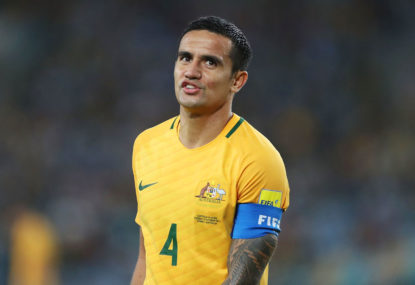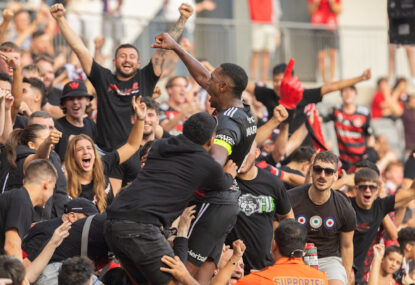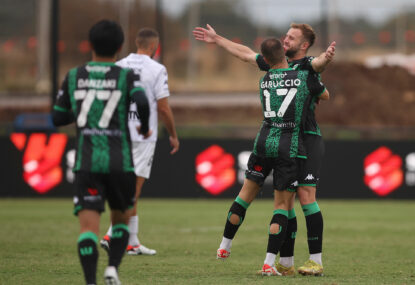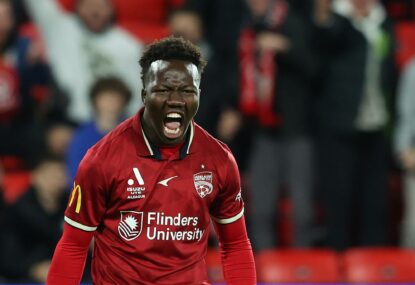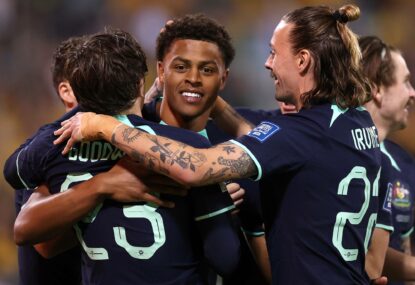Australia have played two of their three group stage World Cup games, scoring two goals from the penalty spot courtesy of the ice-cool Mile Jedinak.
But that’s the problem.
The Socceroos are yet to score from open play and impressed against the French.
And if it weren’t for the outstretched boot of Paul Pogba, the Socceroos could’ve snatched a point from their more fancied opponents.
Against Denmark, the Socceroos rallied after conceding early and had the running for most of the match – but failed to capitalise on the pressure they built.
Time and again balls were looped into the box and the majority of the time, they were cleared by Andreas Christensen or Simon Kjaer.
Andrew Nabbout, for all his harrying and outright lung-busting efforts, is not a threatening striker capable of making seasoned defenders sweat.
Nor is he suited to the style of game Van Marwijk uses. If you play with a sole striker, then that striker needs to be a threat in the air as well as along the ground.
Australia’s Josh Risdon and Aziz Behich did exactly what Van Marwijk asked of them. They bombed down their respective wings, overloading one side of the pitch to deliver a cross into the box.
Yet with no aerial presence or indeed great goal scoring presence in the box, the Danes were fairly comfortable clearing their lines.
Australia’s greatest threats came from incisive runs from Daniel Arzani and Matthew Leckie.
The most frustrating part of Australia’s performance against Denmark was Van Marwijk’s ignoring of Tim Cahill.

(AP Photo/Martin Meissner)
With time ticking away and Australia needing a win to ensure they had control of their World Cup destiny, he brought on Jackson Irvine.
Irvine is a midfielder with 18 goals to his name from 170 senior club appearances. He’s netted twice in his 21 games for the Socceroos.
The situation called for the injection of Cahill. A genuine goal threat who would benefit from the balls being bombed into the box by Australia’s wing-backs.
It’s frustrating to watch Australia’s World Cup hopes slip away.
Now, they rely on results from France versus Denmark while the country’s greatest goal-scorer and proven match-winner warms the bench for the first 180 minutes of the tournament.
If Van Marwijk wasn’t going to play him, then why pick him?
You don’t just select a player because they’ll be good to have in the squad – especially a player like Cahill.
He doesn’t need Cahill to play 90 minutes, but he does need to play him.
Denmark sat deeper and deeper as the match wore on, inviting pressure but seeming pretty comfortable defending against a combination of Irvine, Nabbout, Leckie, Arzani, Rogic, Juric, Jedinak and Mooy who have a combined total of 57 goals at international level.
Of those goals, 20 have come from the boot of Jedinak with 12 coming from penalties.
Jedinak isn’t a striker and Cahill has scored 50 goals at senior level for Australia.
I understand that Australia’s style is heavily predicated on the need to press and harry the opposition.
But what good is all the harassing, pressing and lead up work worth if you don’t have a goal threat on the end of it?
It’d be like Liverpool implementing Jurgen Klopp’s counter-pressing style with Rickie Lambert at the head of the attack instead of Mohamed Salah.
The ABC’s Dean Bilton makes the argument that playing Cahill could break down Australia’s build-up work and hand back the initiative to the opponent.
He also says Nabbout’s work opens up room for Leckie, Kruse and Rogic.
How has that worked out?
Against France, Australia had just one shot on target and against Denmark, they had five shots on target.
Across two games, Australia has managed just six shots on goal and not one goal from open play.
He also hurts his own argument by saying Nabbout lacks technical skills but makes up for it in his defensive efforts and his stretching of the opposing back four.
Last time I checked, you want a striker capable of finishing with technical skills so they can hold up the ball when needed, beat a defender, lay it off to a teammate or finish with one touch.
You also want a striker opposition defenders are worried about and have to consistently ensure they’re being marked.
Often when that happens, more space opens up for his teammates.
Bilton’s argument is also based purely on speculation about how the game might play out.
Cahill could also score with the first ball bombed into the box.
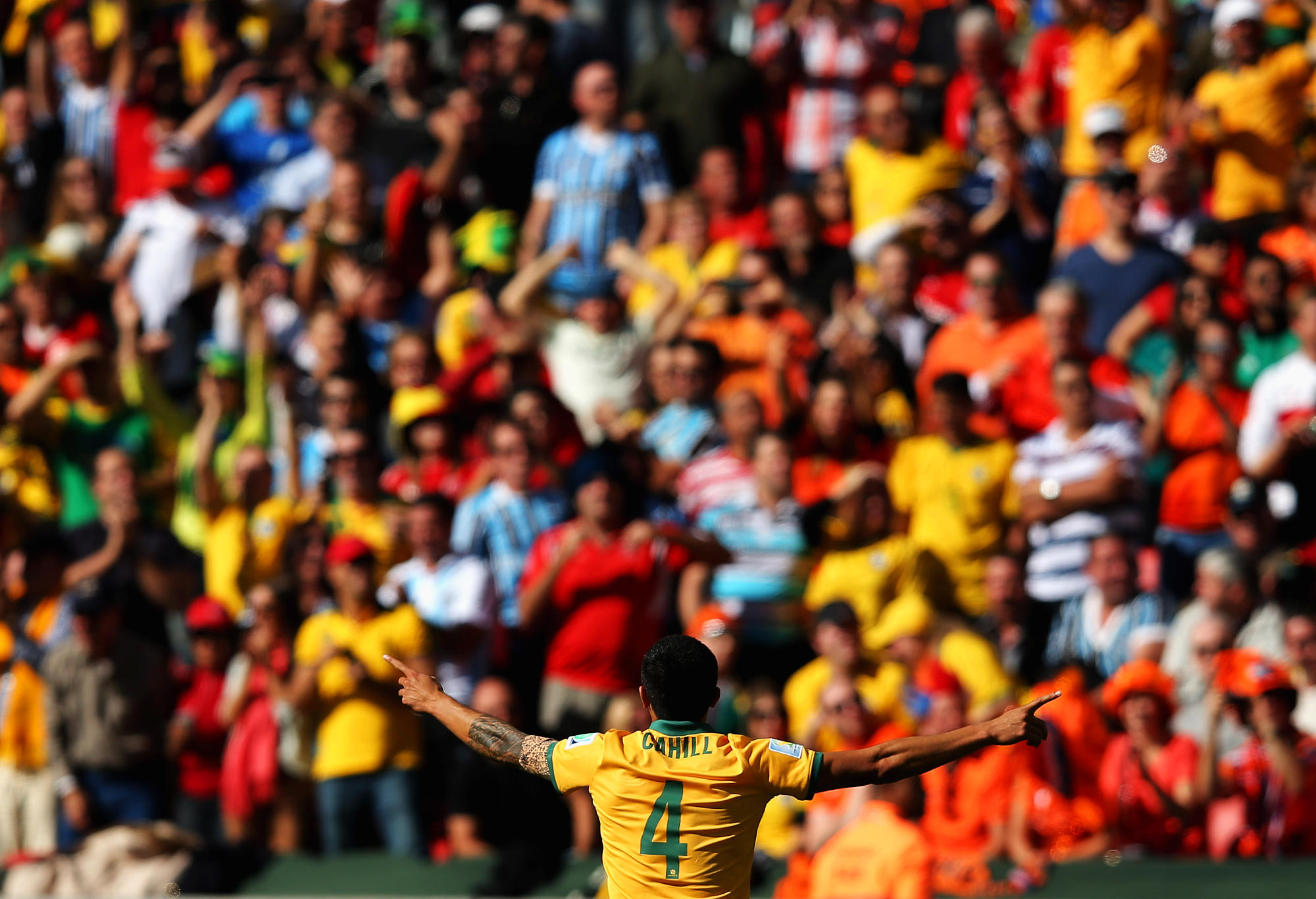
(Photo by Dean Mouhtaropoulos/Getty Images)
But my question here is:
Do we want to bow out of this tournament in a match where we aim simply not to lose, or do we want to have a crack and leave nothing to chance?
If Van Marwijk’s reasoning for leaving Cahill on the bench is because he might upset the team balance, then he should never have picked him.
This isn’t a plea from a sentimental perspective – Australia needs goals and Australia’s greatest goal scorer is sitting on the bench.
If Australia fails to breach the Peruvian defence in open play and Cahill does not take the field, Socceroo supporters will have every right to feel aggrieved at Van Marwijk’s tactics.
Nabbout is out for the rest of the tournament and a replacement will have to come in.
If Australia wants at least a chance to progress, Cahill will likely need to take the field at some point in the match.





























































































